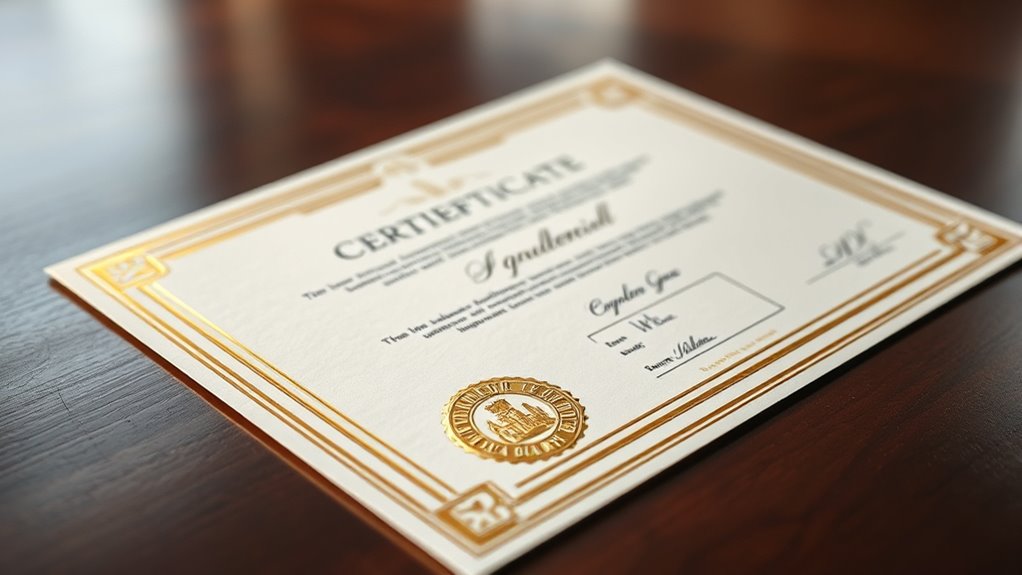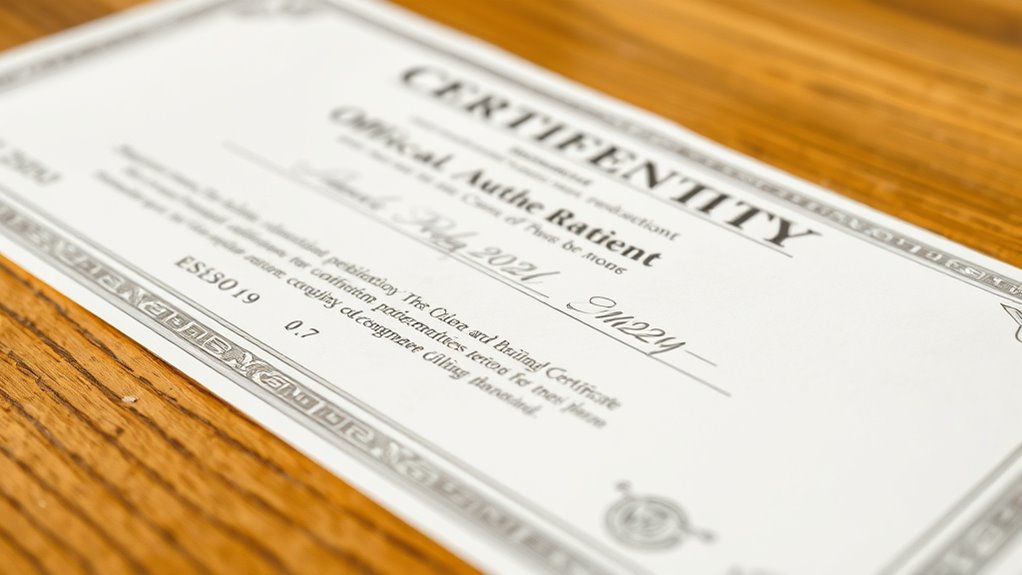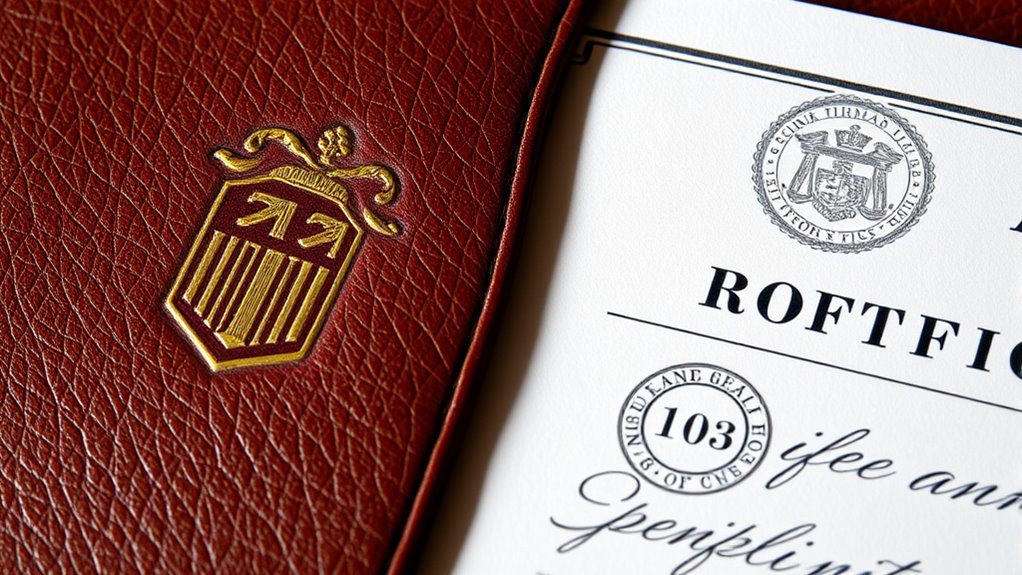When creating authenticity certificates, guarantee they include visible security features like watermarks or holograms, along with a unique serial number for easy tracking. Make sure issuer details, including signatures or stamps, are clear and verified, and describe the item or service in specific terms. Don’t forget to include the date of issue and the validity period. Want to learn exactly what else should be part of an effective certificate? Keep exploring to find out.
Key Takeaways
- Unique serial number or code for verification and record-keeping.
- Clear issuer information, including signature or digital signature.
- Visible security features such as holograms or watermarks.
- Detailed description of the item or service being certified.
- Issue date, validity period, and conditions for renewal or expiration.
Clear Identification Details

Clear identification details are essential for verifying the authenticity of certificates. Incorporate security features like digital watermarking, which embeds invisible data into the certificate, ensuring it’s genuine. Hologram security also plays a vital role, providing a tamper-evident element that’s difficult to duplicate. These features help you distinguish authentic certificates from counterfeits at a glance. Make sure the certificate includes clear details such as the recipient’s name, date of issue, and issuing authority, all printed prominently. Combining these visible elements with covert security measures creates a robust verification system. Additionally, implementing security features in Gold IRA certificates enhances the protection against counterfeiting and forgery. By ensuring your certificate has distinct identification details, you make it much harder for counterfeiters to forge or manipulate, safeguarding the integrity of your certification process. Incorporating security zone info can further improve verification by providing trusted references and standards. Utilizing standardized security protocols can also bolster the certificate’s resilience against forgery. Moreover, establishing regular audits and updates for security features ensures ongoing protection against emerging counterfeit techniques.
Unique Certificate Number or Serial Code

In addition to visible security features, assigning a unique certificate number or serial code substantially enhances the verification process. This serial number, often called the certificate code, guarantees each certificate is distinct, preventing duplication or fraud. Including a serial number allows quick cross-referencing with official records, boosting trust. To help you understand its importance, here’s a simple table:
| Certificate Element | Purpose | Example |
|---|---|---|
| Serial Number | Unique identification | SN123456789 |
| Certificate Code | Verifies authenticity | CERT-2024-XYZ123 |
| Issue Date | Records issuance | 2024-04-27 |
| Expiry Date | Validity period | 2026-04-27 |
| Issuer’s Serial | Traceability of issuer | ISS-987654321 |
This serial number or certificate code fortifies the certificate’s credibility and ensures easy verification. Implementing robust verification methods such as secure databases or digital signatures can further strengthen the process. Ensuring each certificate has a unique identifier minimizes the risk of forgery and maintains the integrity of the certification process. Additionally, adopting standardized formats for serial numbers can improve consistency and reliability across different certificates. Proper management of privacy policies related to certificate data ensures compliance with data protection regulations. Regular audits of the issuance process can also help sustain the system’s overall security and trustworthiness.
Issuer’s Information and Signature

Including the issuer’s information and signature is essential for establishing the authenticity of a certificate. This ensures you can verify its legitimacy through digital verification methods and confirm legal compliance. To achieve this, the certificate should feature:
- Clear issuer details, such as name and contact info
- Official signature or stamp, either physical or digital
- Digital signatures for secure verification
- Certification authority or organization’s credentials
- The presence of vetted information helps ensure the certificate’s credibility and trustworthiness. Additionally, incorporating authenticity features can further enhance the verification process. These components help you validate the certificate’s origin and integrity efficiently. The digital verification process relies heavily on the issuer’s signature, confirming the document’s authenticity. Ensuring all these elements are present not only upholds legal standards but also incorporates trust-building elements that reinforce confidence in the certificate’s legitimacy. Incorporating security measures like encryption can help prevent forgery and tampering. Including tamper-evident features can also enhance the security of the certificate against fraudulent alterations.
Description of the Item or Service

Are you wondering how to accurately describe the item or service listed on a certificate? Clear, detailed descriptions help verify authenticity and prevent confusion. Include specifics like material, size, model, or service details. If applicable, mention relevant pricing strategies, such as value-based or market-driven approaches, to clarify the item’s worth. Certification formats vary, so choose a format that best highlights the description—whether as a technical specification, a brief summary, or a thorough overview. Confirm the language is precise and consistent with other document parts. A well-crafted description helps both buyers and authorities confirm authenticity quickly, reducing doubts and disputes. Additionally, understanding Angel Number Soulmate concepts can help identify meaningful signs during verification processes, ensuring the authenticity is aligned with spiritual symbolism. Keep it straightforward, factual, and aligned with the overall purpose of the certificate. Additionally, understanding electricity production from bike generators can be useful when scheduling in-person verifications or consultations.
Date of Issuance and Validity Period

The date of issuance and validity period are essential details that establish the timeframe during which the certificate is considered accurate and trustworthy. Including these details enhances digital verification and helps prevent counterfeits. You should guarantee the certificate clearly states:
- The exact date it was issued to verify authenticity quickly.
- The validity period, specifying how long the certificate remains valid.
- Any renewal or expiration dates to maintain up-to-date verification.
- Conditions for extending or updating the period, aiding counterfeit prevention.
Frequently Asked Questions
How Can I Verify the Authenticity of a Certificate Online?
To verify the authenticity of a certificate online, you should start with digital verification tools provided by the issuer. Look for authenticity markers such as holograms, QR codes, or serial numbers on the certificate. Scan QR codes or enter serial numbers on official verification websites. These steps help make certain you’re checking a genuine document and can confirm its legitimacy quickly and securely.
What Legal Considerations Are Involved in Issuing Certification Documents?
Imagine a lighthouse guiding ships safely—your certification documents serve the same purpose. When issuing them, you must guarantee legal compliance and certification validity, which act as your guiding light. You’re responsible for adhering to laws that protect both issuer and recipient, avoiding fraud and ensuring recognition. By following these legal considerations, you build trust and uphold integrity, making your certificates a beacon of authenticity in a sea of doubt.
Are There Industry Standards for What Should Be Included in an Authenticity Certificate?
You should know that industry standards and certification requirements guide what’s included in an authenticity certificate. These standards typically require details like the item’s origin, a description, serial or registration numbers, and the certifier’s signature or stamp. Following these guidelines guarantees your certificate is valid, trustworthy, and compliant with industry expectations, which helps verify authenticity and maintain credibility for your product or item.
How Should Discrepancies or Damages to a Certificate Be Handled?
When handling discrepancies or damages to a certificate, you should prioritize prompt discrepancy resolution and damage reporting. You need to document the issue clearly, contact the issuer immediately, and provide proof if possible. Keep records of all communications and request a corrected or replacement certificate. Addressing damages quickly guarantees the authenticity remains credible, and thorough damage reporting helps prevent future issues and maintains trust with clients and stakeholders.
Can Certificates Be Amended or Updated After Issuance?
Did you know that over 60% of certificates are amended or updated within five years? When it comes to your authenticity certificates, yes, they can be modified or updated after issuance. You need to follow specific amendment procedures and update protocols, which usually involve submitting a formal request, providing supporting documentation, and sometimes paying a fee. Always check with the issuing authority to ensure your certificate remains accurate and valid.
Conclusion
Think of an authenticity certificate like a passport—it proves who you are and what you own. Just like a passport needs your photo, serial number, and issuing authority, your certificate should include clear details to verify its legitimacy. When you include all essential elements, you’re creating a trustworthy shield around your item or service. Without it, it’s like traveling without ID—risky and uncertain. Make sure your certificate is complete to keep everything secure and verified.









